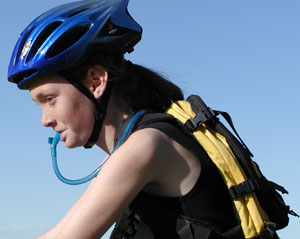|
Stay Hydrated It's hot out there and your body loses more water than you think |
|
Remember those westerns, where Rowdy Sixgun loses his trusty mount and has to hoof it across the desert? Recall his parched lips, hangdog gaze and wobbly walk? That's how it feels to bicycle in the hot summer sun if you make the mistake of not drinking enough water. At first, you feel cool because you generate a breeze pedaling along. Forget to drink, though, and the sun's rays and your efforts leave you salt stained, rubbery legged and barely able to balance.
Make Mine A Double
Fortunately, you won't ever experience such hardship if you make sure that you carry and drink an ample supply of liquid.
If your bicycle doesn't have them already, you can purchase and attach fittings called "water-bottle cages" that hold bottles next to the frame. Most bicycles will accept two. That's enough liquid for approximately two hours, depending on where and how hard you're riding.
Water bottles are convenient because they are held on the frame, not on the body and they're relatively easy to clean and fill. They typically come in two sizes, one about 20- ounce capacity and the larger model, about 30-ounce. Carry sizes that make sense for how and where you're riding. Obviously, you don't need to tote any more water than your ability to refill the bottles. So, if you're riding where there are stores, you might be able to get away with a single bottle, assuming you don't mind stopping to refill.
There are plenty of water-bottle types, too, from basic models, to those with special tops to insulated models made to keep liquid cooler, longer. Usually, even the fanciest bottles are very affordable.
Hydration Packs
For longer rides and outings far from civilization, an excellent alternative (or addition) to water bottles is the hydration pack. These are water "bags," which you wear on your back or waist. For water delivery, they feature flexible tubes ("hoses") with self-sealing mouthpieces. The mouthpiece rests close to your face for easy access so you can sip whenever you want.
Though more expensive than water bottles, hydration packs have many advantages. The biggest is that they carry more water so you can go further without refilling (packs come in different sizes with capacities up to 70 to 100 ounces of water!). Also, you don't have to reach down and extract a bottle from its holder to sip, which means you'll probably drink more and remain in complete control of the bike.
Some riders feel that riding with water on their backs keeps them cooler, too. The packs provide additional carrying capacity, making it possible to tote a jacket and tools. And, with the pack's water-delivery tube at shoulder height, it stays clean. There's no risk of drinking from a contaminated bottle that's been blasted with germs from the spray off the front tire.
Hydration Tips
